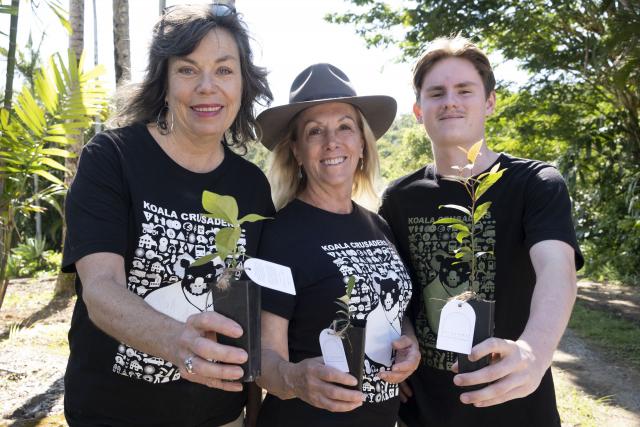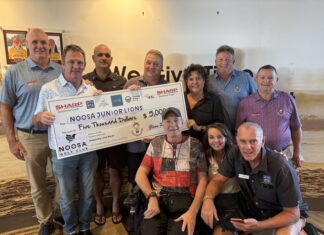
Planting trees, strengthening habitat corridors and increasing the genetic diversity of local koalas are just some of the endeavours in Queensland Koala Crusaders sights in their multi-faceted, collaborative efforts to ensure the survival of the koala, now listed as endangered.
Last Sunday, during Save the Koala month, QKC members joined Sunshine Butterflies to plant almost 300 trees at the Alsahwa retreat at Verrierdale in a commemorative act to honour The Queen’s 70 years reign and unveil a plaque to mark the occasion.
QKC, which was formed following the Sunshine Coast Koala Summit in 2012, is working with governments, universities and wildlife organisations to advocate for the koala and improve its conservation outcomes.
On the ground they are planting koala food trees to restore habitat, rescuing, rehabilitating and releasing sick and injured koalas through the Noosa Region Koala Rescue Group they founded with the assistance of Wildcare Australia, and helping to educate the community about koalas.
Through communication and collaboration between stakeholders QKC seeks to facilitate fresh cooperative approaches to the chronic challenges regarding the sustainability of the wild koala as a species.
Much work and research is being undertaken by a multitude of groups including the University of Sunshine Coast (USC) with significant projects including the creation by Professor Peter Timms and his team of a vaccine which is currently being trialled, with great success, to treat chlamydia, a sexually transmitted and devastating disease for koalas.
“There’s so much more to be done,” QKC ambassador Meghan Halverson said.
“We don’t understand what koalas do when relocated. We don’t know why they feed off one tree but reject the next one.”
Meghan said they hoped the key to their preferential feeding might be found in current research into leaf and soil chemistry.
“It’s one of the projects we’re keenly interested in getting involved in,” she said.
“What we’re doing is reaching out to universities and people working in research and asking what is your dream project? What do you think needs to happen?” QKC president Linda Barnes said.
One project raised is the creation of an App in which records of koala sightings could be kept and added to by members of the public, she said.
The group has been talking to CSIRO about the project and are seeking funding of $200,000 through grants or private funding to cover its costs.
“There’s a lot of speculating on how many koalas there are,” Meghan said. “A lot of areas have not been mapped. There are areas where no surveys have been done.”
Through the work of the USC Detection Dogs Conservation Team founded in 2015 by USC researcher Dr Romane Cristescu and Associate Professor Celine Frere USC and drone monitoring as well as help from other researchers and citizen scientists they hope to gain a better understanding of the size of the population.
What the group do know is that koalas living in urban areas are suffering with loss of habitat from development, car strikes and dog attacks.
Development has restricted their ability to travel across their natural environment to find mates to maintain a healthy genetic diversity.
Genetic testing has shown the local koala population are a match, sharing the same genetic make up, Meghan said.
The group hopes recent changes to laws allowing the translocation of rescued koalas to be increased from 5km to 50km from their point of rescue, and a research program underway at University of Sunshine Coast (USC) would enable the introduction of rescued juvenile males to breed a more genetically diverse and healthier population.
A strong focus for QKC is the planting of trees to re-establish koala habitat.
QKC would welcome a Koala Protection Act that would offer greater protection for koala habitat “but getting the government to come on board might take forever” and action is needed now before time runs out for the species.
“They need all the help they can get and my hope comes from the many trees we are putting into the ground to connect and regenerate the landscape for koalas and other species,” Meghan said.
QKC admit many people they speak to have given up hope of the survival of the iconic species but many have not.
“Hope is contagious and so is despair,” Linda said. “If we can’t be hopeful, why are we here.”






